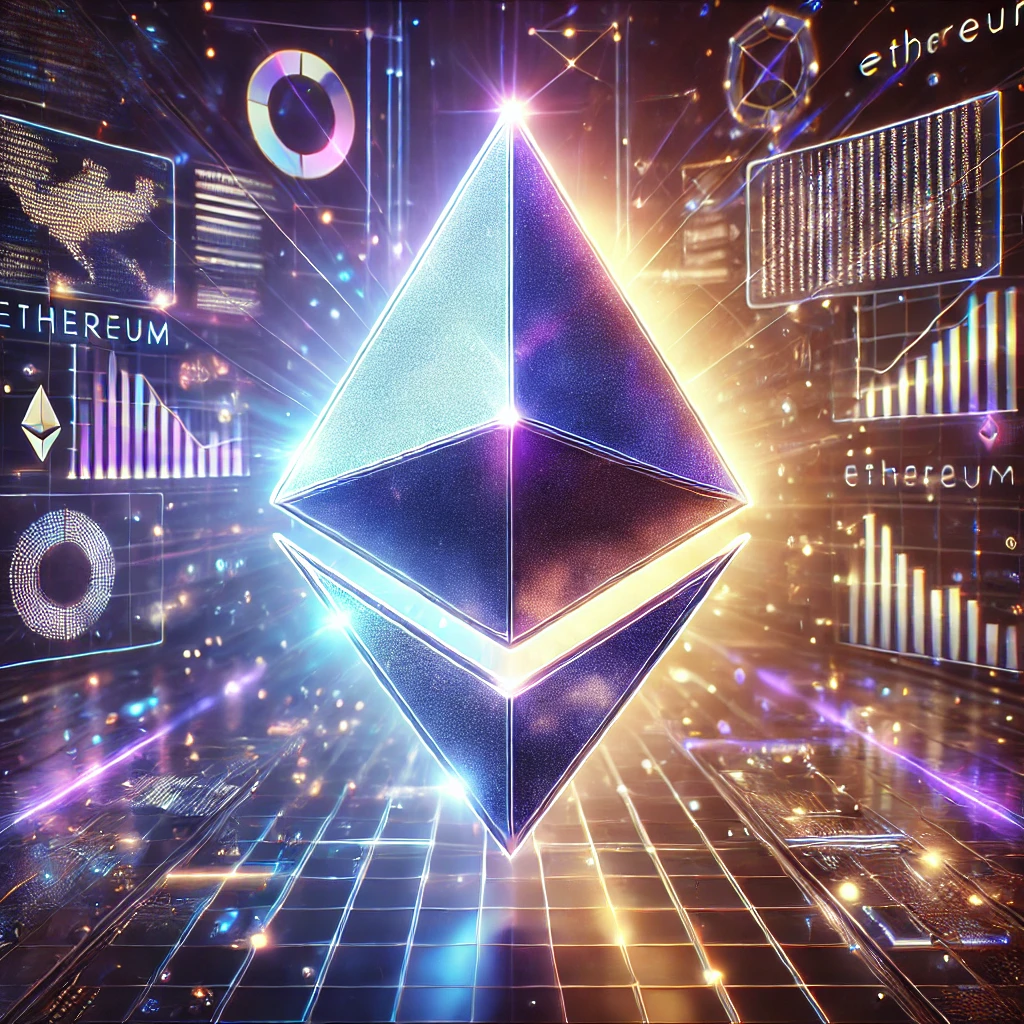近年、暗号資産(仮想通貨)市場の拡大やブロックチェーン技術の進化に伴って、ビットコインに次いで注目を集めるのがイーサリアム(Ethereum)です。本記事では、イーサリアムの仕組みや特徴、ビットコインとの比較、そして将来性や投資面でのポイントを専門的かつ分かりやすくまとめました。これからイーサリアムについて学びたい方や、ブロックチェーンを活用したビジネスや投資を検討している方にとって、有益な情報を網羅していますので、ぜひ最後までご覧ください。
イーサリアム(Ethereum)とは
イーサリアム(Ethereum)は、ビットコインに次ぐ時価総額を誇る暗号資産のひとつです。しかし、その本質は単なる「仮想通貨」ではなく、ブロックチェーン技術を活用した分散型アプリケーション開発プラットフォームである点にあります。2013年にヴィタリック・ブテリン(Vitalik Buterin)氏によって構想され、2015年に正式にリリースされました。
イーサリアムは、ビットコインのように単純な「価値の移転」のみを扱うのではなく、「スマートコントラクト(自動契約)」を実行できる汎用性の高いブロックチェーンを提供しています。これにより、仲介者を介さずに契約や取引を自動化できるため、金融やゲーム、芸術、クラウドファンディングといった幅広い分野で応用が進んでいるのです。
イーサリアムの仕組みと特徴
スマートコントラクトとEVM
イーサリアムの最大の特徴は、「スマートコントラクト」をブロックチェーン上で実行できることです。スマートコントラクトとは、契約内容や取引条件をプログラムとして記述し、条件が満たされると自動で実行される仕組みを指します。
イーサリアムでは、このスマートコントラクトの実行をサポートするEVM(Ethereum Virtual Machine)と呼ばれる仮想マシンが、ブロックチェーン上に分散して動作しています。EVMは、イーサリアムネットワーク上に参加している各ノード(コンピュータ)によって維持され、プログラムが正しく実行されるかを相互に検証し合う仕組みです。
- メリット
- 中央管理者が不要(分散型)
- 改ざんが極めて困難
- 契約実行の透明性・自動化
- デメリット
- プログラムのバグや仕様ミスが起きた場合に対処が難しい
- 大量のトランザクション処理が集中すると、ガス代が高騰する
DApps(分散型アプリケーション)
イーサリアムは、スマートコントラクトを活用したDApps(Decentralized Applications)の開発基盤として重宝されています。DAppsは、特定の企業やサーバに依存することなく、ネットワーク上の多数のノードにより維持・管理されます。
- 具体例
- 分散型取引所(DEX):ユーザー同士が直接暗号資産を交換
- 分散型ゲーム:ゲーム内通貨やアイテムの管理がブロックチェーン上で行われる
- 分散型SNS:運営者の検閲リスクが少なく、自由な発信が可能
こうしたDAppsのエコシステムが拡大したことで、イーサリアムは「世界のコンピュータ」とも形容されるほど、ブロックチェーン上の重要インフラとなってきました。
イーサ(Ether)とガス代(Gas Fee)
イーサリアムは、「イーサ(Ether, ETH)」と呼ばれる独自のトークンを発行しています。イーサリアム上でスマートコントラクトを実行する場合や、DAppsを利用する際に必要となるのが「ガス(Gas)」と呼ばれる取引手数料です。
- ガス代(Gas Fee): スマートコントラクトの複雑さやデータ量に応じて必要となる手数料。ネットワークが混雑するとガス代が高騰することもある。
- マイナー(もしくはステイカー)への報酬: 取引やスマートコントラクトを処理するためにリソースを提供するノードへ、ガス代が報酬として支払われる。
このイーサは、取引所でビットコインや法定通貨(円・ドルなど)と交換が可能なため、暗号資産としての投資対象にもなっています。
ビットコインとの違い
同じブロックチェーン技術を利用しているにもかかわらず、イーサリアムとビットコインは以下の点で大きく異なります。
- 目的の違い
- ビットコイン:デジタル通貨として、価値の移転手段を主目的とする
- イーサリアム:汎用的なブロックチェーン上でスマートコントラクトを実行するプラットフォーム
- プログラミングの柔軟性
- ビットコイン:スクリプト機能は限定的
- イーサリアム:高機能なスマートコントラクト(Turing Complete)
- 発行上限
- ビットコイン:2,100万BTCという発行上限が存在
- イーサリアム:現状、厳密な上限はなく、今後のアップグレードで発行量が抑制される仕組みを導入中
両者を比較すると、ビットコインは「デジタルゴールド」とも呼ばれるように価値の保存に強みがあり、イーサリアムは多機能なアプリケーション基盤として活用されるケースが増えています。
具体的なユースケース
DeFi(分散型金融)
DeFi(Decentralized Finance)は、イーサリアム上で提供される金融サービスの総称です。従来の銀行や証券会社といった中央管理者を介さず、スマートコントラクトを用いて融資や預金、トレードなどを行うことが可能です。
- 代表的なDeFiプロトコル
- Aave: 貸し手と借り手を直接つなぐレンディングプラットフォーム
- Uniswap: AMM(自動マーケットメーカー)方式の分散型取引所
- MakerDAO: 担保を預けることでステーブルコイン「DAI」を発行する仕組み
DeFiを利用するメリットとして、中間業者がいないために手数料が抑えられる、資産の管理を自分で行えるなどが挙げられます。ただし、スマートコントラクトのバグや流動性リスクなどもあるため、利用者には一定の知識と注意が必要です。
NFT(Non-Fungible Token)
NFT(非代替性トークン)は、イーサリアムのERC-721規格によって広く普及しました。従来の暗号資産が1枚1枚同じ価値を持つ「代替可能トークン」(Fungible Token)であるのに対し、NFTは唯一無二の価値を表すことができます。
- 活用領域
- デジタルアート:作家によるオリジナル作品の所有権を証明
- ゲームアイテム:希少アイテムをNFT化し、自由に売買可能
- メタバース:仮想空間内の土地や建物をNFTとして所有・取引
NFT市場は2021年〜2022年にかけて爆発的な盛り上がりを見せ、多くの投資家やクリエイターが参入しました。今後もゲームやメタバース、音楽、ファッションなど幅広い分野での応用が期待されています。
DAO(Distributed Autonomous Organization)
DAO(分散型自律組織)とは、ブロックチェーン上のスマートコントラクトを利用して運営・意思決定を行う自律組織を指します。イーサリアムが提供する仕組みを活用し、投票や資金管理を透明かつ改ざん不可能な形で実施できます。
- メリット
- 中央管理者なしで運営が可能
- スマートコントラクトによる自動化(コスト削減や効率化)
- 組織の透明性向上
DAOは企業形態の新たな選択肢として注目されており、今後、スタートアップやコミュニティ、さらには社会的プロジェクトなどでの導入が加速すると考えられています。
イーサリアム2.0(Consensus Layer)とアップグレードの展望
イーサリアムは利用者の急増やスマートコントラクトの普及に伴い、スケーラビリティ(処理能力)や高いガス代といった問題に直面しています。これらを解決するために進められているのが、イーサリアム2.0(現在は「Consensus Layer」へのアップグレードと呼ばれる段階的な改修)です。
- PoW(Proof of Work)からPoS(Proof of Stake)への移行
- マイニングによる大量の電力消費を削減し、環境負荷を軽減
- ステイカー(保有者)がブロック生成に参加できるようになり、51%攻撃への耐性も向上
- シャーディング(Sharding)の導入
- データベースを分割し、処理を並列化することでトランザクション処理能力を大幅に向上
- ネットワーク全体の負荷を低減し、ガス代の抑制につながる
- その他のアップグレード
- Rollupsなどのレイヤー2ソリューションの拡充
- トランザクションの圧縮・バッチ処理による効率化
これらのアップグレードが進めば、より大量の取引に対応可能となり、ガス代の安定化や低コスト化が見込まれます。加えて、環境負荷の低減も期待されるため、今後さらに企業や開発者がイーサリアムエコシステムに参入する可能性が高まっています。
イーサリアム投資のメリットとリスク
メリット
- DeFi・NFTなどのブームに伴う需要増
スマートコントラクトを活用したDAppsやDeFi、NFTの利用が拡大するほど、ガス代や担保として利用されるイーサ(ETH)の需要は高まります。 - 技術革新による価値向上の可能性
イーサリアム2.0の導入やレイヤー2ソリューションの拡張により、ネットワーク全体の利便性が高まり、イーサの需要も長期的に増加する可能性があります。 - 多様なサービスの基盤である
金融だけでなく、ゲーム、アート、メタバースなど多岐にわたる分野で利用されているため、エコシステムの拡張余地が大きいと考えられます。
リスク
- 価格変動リスク
暗号資産全般に言えることですが、イーサの価格は日々大きく変動し、短期間での値下がりリスクがあります。 - 技術的リスク
スマートコントラクトにバグや脆弱性が見つかった場合、大規模な損失やセキュリティ問題につながる恐れがあります。また、アップグレードが遅延・不具合を起こす可能性も否定できません。 - 競合プロジェクトの台頭
SolanaやPolkadot、BNB Chainなど、より高速なトランザクション処理や低ガス代を強みにしたブロックチェーンも登場しています。今後、イーサリアムがこれらの競合に対抗できるかは注目点となります。 - 法規制リスク
国や地域によっては暗号資産の規制が強化される場合があり、プロジェクトの開発や取引に影響が出る可能性があります。
まとめ:イーサリアムの未来
イーサリアムは、スマートコントラクトを活用できる汎用的なブロックチェーン基盤として、ビットコインとは異なる価値を提供してきました。DeFiやNFT、DAOなど、中央管理者を介さずにさまざまなサービスやコミュニティを実現できる点で、「ブロックチェーンの未来を切り拓く存在」ともいわれています。
今後、イーサリアム2.0の導入やレイヤー2ソリューションの普及により、スケーラビリティやガス代の問題が解消されれば、さらに多くのユーザーや企業がイーサリアムエコシステムに参入する可能性が高まるでしょう。技術力の高い開発コミュニティが常に改善に取り組んでいる点も、イーサリアムの強みとして挙げられます。
とはいえ、価格変動やセキュリティ、法規制、競合他チェーンの存在など、イーサリアムに対するリスクも慎重に考慮する必要があります。投資やビジネス活用を検討する際には、最新の開発動向や規制情報を常にチェックし、リスク許容度に合った判断を行うことが重要です。
イーサリアムは「暗号資産」の枠を超え、分散型プラットフォームとして新たな可能性を切り拓いています。今後もブロックチェーン技術の世界的な発展とともに、イーサリアムがどのように進化していくのか、引き続き大きな注目が集まることでしょう。



